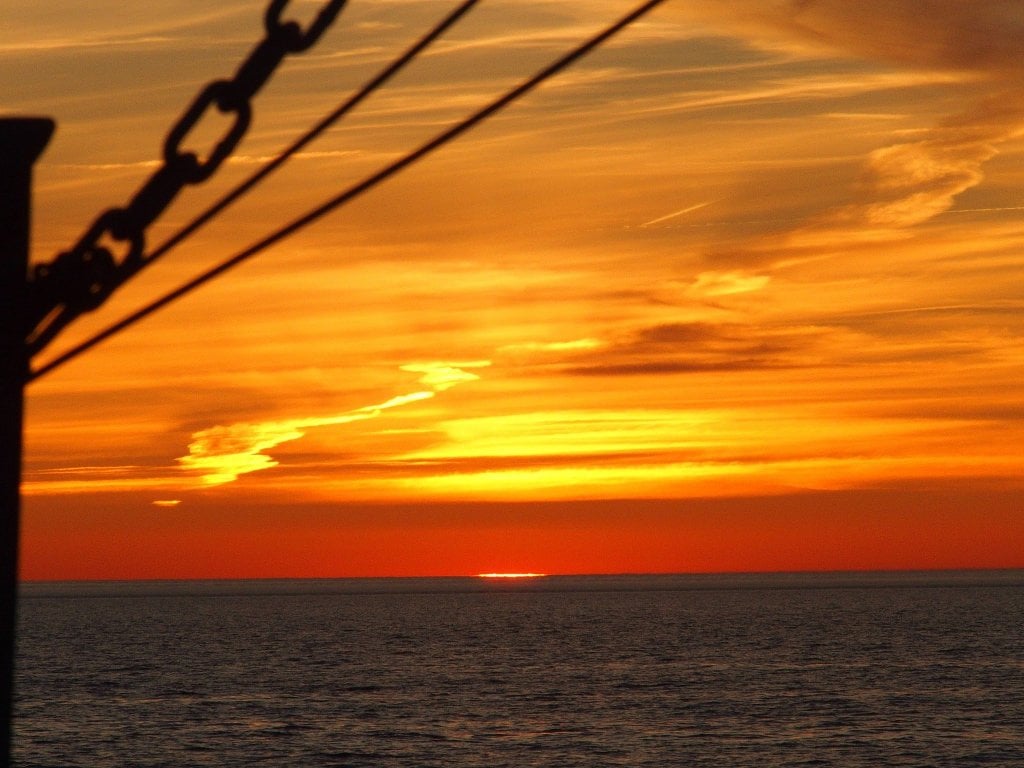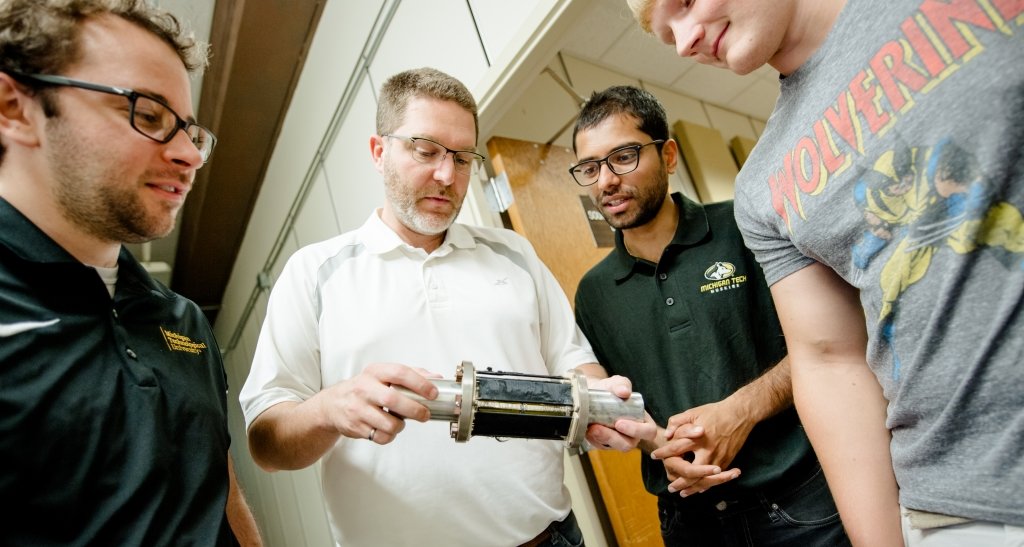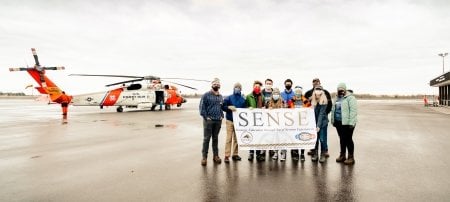UNOLS is run by the National Science Foundation and the Office of Naval Research and maintains all of the US science ship fleet. These are Discovery Channel-worthy vessels doing great science in far flung regions like the Antarctic. There’s also a UNOLS vessel, R/V Blue Heron, operating on the Great Lakes out of University of Minnesota Duluth where researcher Andrew Barnard did his chief scientist training.
June 24, 2016
I have begun my journey onto the Great Lakes.
For the next five days, I’ll be on a ship, learning the ins and outs of being a chief scientist with the University-National Oceanographic Laboratory System (UNOLS), a collaborative program between the National Science Foundation and Office of Naval Research.
I'll be aboard the R/V Blue Heron, the only UNOLS research vessel in the Great Lakes. It’s about 20 feet tall, painted navy blue, with “Large Lakes Observatory, University of Minnesota” printed on the bow. This will be my home for the next several days.
It’s a good thing I don’t get seasick. In fact, I’m in my element on a ship. As an acoustics engineer, I am interested in underwater acoustics and noise in the lakes. This trip will provide with the opportunity to measure background noise in Lake Michigan and Lake Superior as well as how ship noise interacts with ambient noise in deep water.
June 25, 2016
We start the day at the University of Wisconsin-Milwaukee School of Freshwater Sciences and I get introduced to my fellow scientists: a post-doctoral researcher from Woods Hole Oceanographic Institute, a graduate student from the University of California at San Diego, a graduate student from the University of Rochester, and an adjunct faculty member from Rensselaer Polytechnic Institute. I’m the only engineer of the bunch. My fellow scientists are all biological and chemical limnologists, which is far outside of my field, acoustics. It should be an interesting learning experience for all of us.
We spend the morning and early afternoon in the classroom learning about the UNOLS fleet and services, how to budget ships into proposals, and how plan research cruises. After that, we get a tour of the R/V Blue Heron, which is docked just outside the building, and we all start loading our equipment on board. From the dock, I can see down to the water, a dark blue reflecting the clouds on this overcast day. At the dock, the boat is solid and is like working in my lab, albeit with much tighter quarters.

For my part, I have a rack of data acquisition equipment: several hydrophones (underwater microphones), microphones, and accelerometers. My plan is to record the ambient deep water sounds simultaneously with sounds and vibration in the ship’s engine compartment to separate the noise from the research ship with that from the natural surroundings. That means my first task is to crawl around in the engine room of the ship and glue accelerometers onto the important noise makers (main engine, hydraulic pumps, and generator sets). It is a loud, hot, and dirty job, but after about five hours, I have most of the accelerometers placed and cables strung back into the “dry lab” where my data acquisition system is set up.
After some dinner (and maybe a few beers) we retire back to the ship for the night and get settled into our berths. The sleeping arrangements are comfortable—if cozy. I drew the top bunk in my berth, accompanied by two pipes, which gives me about two feet of clearance between the bed and the ceiling. I make a mental note to myself not to sit up in the middle of the night, for risk of concussion. Luckily the bunks are long enough for me—my head touches the headboard and my toes graze the footboard—and I’m out like a light.
June 26, 2016
Today is the day we depart on our cruise from Milwaukee, WI, to Duluth, MN. We wake up to the smell of biscuits in gravy being cooked by the ship steward, Lisa.
Now before I left for the trip, I made sure to check if we needed to bring food and/or snacks. If you know me, you know I’m not one to go without food. I was assured that all food would be provided for us; I went in with pretty low expectations of ship food. But Lisa worked magic in that little ship galley and I have never eaten so well for four consecutive days in my life. All meals were made from scratch and every meal included dessert (yup, even breakfast). We had everything from Pannukakku, a Finnish custard pancake served with fresh cherry sauce, to salmon Wellington with asparagus and potatoes to homemade pizza. After day two on the boat, it was clear I was going to be gaining weight on this trip.
After filling up on biscuits and gravy, we begin our safety briefing. We have a leisurely morning planned since we can’t leave the dock until noon because of some high winds on Lake Michigan. The safety briefing discusses man overboard procedures, talks about life vests and hard hats, and culminates in the donning of the infamous Gumby suits.

An immersion suit (a.k.a. Gumby suit) will save your life if you have to abandon ship in the cold waters of Lake Superior, where even in summer you could die of hypothermia in minutes. It is a very thick dry suit that provides flotation and warmth. This fashionable item is hard to get into because the material is stiff with crab-claw hands, so we have to practice on the ship deck. A lot of tugging, stumbling, and photos later, we're ready to set off.

Science TV shows don't tell you about the long transits on the water and the R/V Blue Heron travels at about 8.5 knots (about 9.8 mph). Our first science station, the deepest point in Lake Michigan, is a 12-hour ride from Milwaukee, making for a drawn-out game of hurry up and wait. The first 30-45 minutes are exciting, just finally being out on the water. Then the rocking sets in.
The R/V Blue Heron is a renovated fishing trawler from the north Atlantic. It is a deep hulled, round bottom boat. That means that it is very stable, but also rocks easily with waves. Even though I have been out on many boats in my life, this one starts to give me a bit of a headache from the wave action. Luckily, I don’t have anything to do for a while, so I’m off for a nap!

I awake rejuvenated and acclimated to the rocking…yet still eight hours away from our first destination. So I decide to measure the sound pressure levels around the ship while we are in transit. I have brought a hand-held sound level meter (Larson Davis 831) along with me for this purpose. Understanding and controlling sound levels on ships is important for many reasons. Ships are loud environments and you don’t want to expose people to sounds that could have lasting and damaging impact on their hearing. Also, sound plays a vital role in the safety on the work deck of the ship. When people are working there are many cranes, winches, and other noisy equipment in use. Communication between people on the work deck is very important, and the louder the mechanical noise is, the harder it is to communicate with each other.
To kill time between stations, I work on some coding on my data acquisition system, learn about the other researchers’ work, and learn a new card game, a variant of Rummy, that the crew plays to pass time. I like to call it Pirate Rummy because it is cutthroat. We arrive at the first science station at about midnight, the deepest point in Lake Michigan. The action begins.

June 27, 2016
On a ship, you don’t wait for the light. You do the science whenever you have the opportunity. So we’re off and running at 12:30 a.m.
First, we deploy a Conductivity-Temperature-Density (CTD) probe.

Then we collect samples of mud (two-foot-deep columns) from the lake bottom, about 250 meters below us. Once on the deck, the cores are partitioned into one-centimeter segments and bagged for further analysis. It took one of my fellow scientists about four hours to segment the cores; she finally got to bed at about 5 a.m.

Meanwhile, I have a chance to record some ambient sound.
For the acoustics work, I lower a hydrophone into the lake at a depth of 200 meters and another at a depth of 18 meters. For the shallow hydrophone, I’m interested in capturing any noise from our boat. The deep hydrophone is meant to capture the ambient noise from elsewhere on the lake.
Why 18 meters and 200 meters, specifically? Well, that’s simple: it’s all the cable I had. While I record the acoustic signatures, I also record the vibration levels of the machinery on the ship. My first recording is with all of the machinery running, except the ship screw isn’t turning because we are stationary. The captain has agreed to shut off all machinery on the ship except for one emergency generator. This is a safety precaution since we don’t want to be stranded in the middle of the lake. I take one more recording with most of the ship equipment powered down. Then we pull up my hydrophones and we are off to the next station. It’s about 2:30 a.m., and I’m off to bed.
Station two is in the Straits of Mackinac just north of the Mackinac Bridge. Up here there is only about 40 meters of water and lots of commercial boats, ferries, and recreational boats. I’m interested in this location as a contrast to the previous station, which was relatively quiet. We do another quick CTD cast and record some acoustic signatures. And take in some the scenery.
June 28, 2016
My alarm goes off at 3 a.m. I didn't want to miss my first lock passing at St. Mary's River in Sault Saint Marie.
It was amazing how fast the lock filled. In about the span of ten minutes, we had risen by 21 feet. To put that in perspective, the lock we went through is 800 feet long and 80 feet wide. Raising it by 21 feet takes about 10 million gallons of water!

After some more sleep and some breakfast, we arrive at our third measurement station off of Whitefish Point in Lake Superior. Another CTD cast, and some stationary acoustic measurements, and we are ready for a new test. I want to measure the sound of the ship as the ship accelerates. This, combined with the information from the sensors on the ship’s engines and transmission, will help me determine what mechanical components are causing the radiated noise from the ship. We extend two hydrophones over the side of the ship and I head down to the dry lab where I am in radio communication with the captain.
Communication is very important on the ship…a lesson I’m about to learn again. The captain wants to turn the ship before starting the experiment, but I don’t relay that message to the crew on the deck. I should have had the crew take the hydrophones out of the water prior to turning. Unfortunately, due to my lack of communication, the hydrophones were left in the water, and during the turn one of them was dragged under the ship and cut off by the propeller. Lake Superior has claimed one of my hydrophones. The lesson learned is to be very particular about communication between crew on different parts of the ship.
It is disappointing to lose an instrument, but we are off to the next station, the deepest point in Lake Superior. We arrive just before sunset, after a long day of steaming through the lake. The waves have subsided to almost nothing and there are almost no clouds in the sky. Here, northeast of Munising, we are in 385 meters (1263 feet) of water.
At this fourth station, I take sound recordings at depths of 200 meters, 100 meters, 50 meters, and 18 meters, all similar depths to measurements I made last year at this same location. The measurements take a bit longer than expected because I am down to only one hydrophone now. But all goes well.
My fellow scientists take several core samples of the bottom, but because it is so deep and very sandy, they cannot get a good core sample. After four tries (about 30 minutes per attempt) we give up on the core sampling. Next we use McLane pumps to perform microbiology surveys near the bottom, at half depth, and near the surface. A McLane pump is a submersible pump that moves water through cascading mesh filters of differing porosity to trap micro-scaled creatures in the water. The nice part of the McLane pump is that you can sample a much larger volume of water without having bring the water up to the ship. It takes about an hour to pump water. Then we recover the pumps and we are off to our next station. It’s about 11 p.m. and this will be a long steam as the next stations are west of the Keweenaw Peninsula. I head to bed on calm seas. It will be good sleeping tonight.

June 29, 2016
After waking up, I head up for breakfast and enjoy another delicious meal. I check out the GPS track and see we are just north of Eagle Harbor after rounding the Keweenaw. It’s a cool, calm morning so I head out to the deck to enjoy some views of the Keweenaw and take advantage of some unexpected 4G wireless signal. After an hour on deck, I head in to the galley and take another look at the GPS track. All of the sudden our course changes from due west to due south. We’re heading right for the north entry of the Keweenaw Waterway. This wasn’t in our course plan.
A short consultation with the captain and I find out that our septic tank on the ship is unexpectedly full and we have to stop and get pumped. We are headed into Lily Pond, the harbor of refuge in the portage canal just south of McLain State Park. We call several septic companies to see if they can meet us at the dock to pump our tanks. The first few hang up on us, not believing the request is legitimate. Finally we reach someone who takes us seriously and is available.
My last scheduled measurement station was the deep spot in Lake Superior and now I’m only seven miles from home. So I make the call to literally jump ship when we reach Lily Pond. Unexpectedly, I’m home two days early and the rest of the team is off for some more measurements on the way to Duluth.

Michigan Technological University is an R1 public research university founded in 1885 in Houghton, and is home to nearly 7,500 students from more than 60 countries around the world. Consistently ranked among the best universities in the country for return on investment, Michigan's flagship technological university offers more than 120 undergraduate and graduate degree programs in science and technology, engineering, computing, forestry, business, health professions, humanities, mathematics, social sciences, and the arts. The rural campus is situated just miles from Lake Superior in Michigan's Upper Peninsula, offering year-round opportunities for outdoor adventure.













Comments